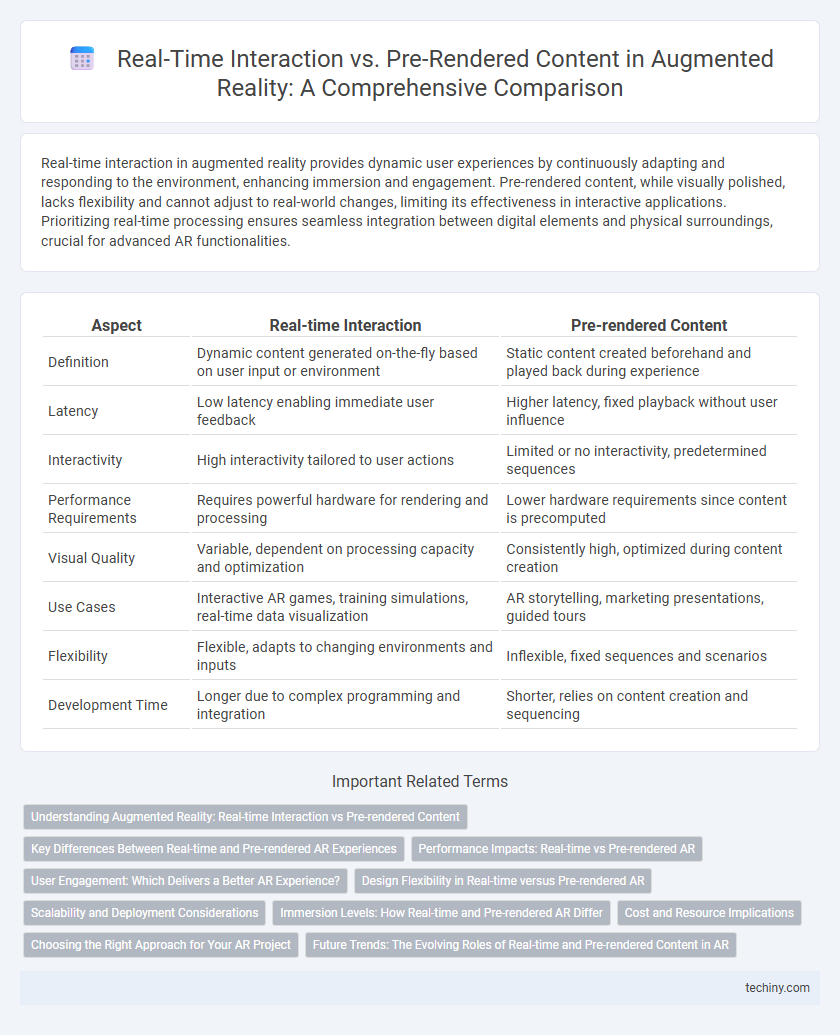Real-time interaction in augmented reality provides dynamic user experiences by continuously adapting and responding to the environment, enhancing immersion and engagement. Pre-rendered content, while visually polished, lacks flexibility and cannot adjust to real-world changes, limiting its effectiveness in interactive applications. Prioritizing real-time processing ensures seamless integration between digital elements and physical surroundings, crucial for advanced AR functionalities.
Table of Comparison
| Aspect | Real-time Interaction | Pre-rendered Content |
|---|---|---|
| Definition | Dynamic content generated on-the-fly based on user input or environment | Static content created beforehand and played back during experience |
| Latency | Low latency enabling immediate user feedback | Higher latency, fixed playback without user influence |
| Interactivity | High interactivity tailored to user actions | Limited or no interactivity, predetermined sequences |
| Performance Requirements | Requires powerful hardware for rendering and processing | Lower hardware requirements since content is precomputed |
| Visual Quality | Variable, dependent on processing capacity and optimization | Consistently high, optimized during content creation |
| Use Cases | Interactive AR games, training simulations, real-time data visualization | AR storytelling, marketing presentations, guided tours |
| Flexibility | Flexible, adapts to changing environments and inputs | Inflexible, fixed sequences and scenarios |
| Development Time | Longer due to complex programming and integration | Shorter, relies on content creation and sequencing |
Understanding Augmented Reality: Real-time Interaction vs Pre-rendered Content
Augmented reality relies on real-time interaction to seamlessly overlay digital elements onto the physical environment, enabling users to engage dynamically with responsive content. In contrast, pre-rendered content delivers static or pre-generated visuals that lack adaptability, limiting user immersion and contextual accuracy. Prioritizing real-time data processing enhances AR experiences by accurately reflecting changes in the user's surroundings and actions.
Key Differences Between Real-time and Pre-rendered AR Experiences
Real-time AR experiences leverage dynamic data processing to enable interactive, context-sensitive environments, allowing users to manipulate virtual objects and respond instantly to changes in their surroundings. Pre-rendered AR content relies on static, pre-generated visuals that offer high-quality graphics but lack the flexibility for user-driven interaction or adaptation to real-world variables. The key differences lie in responsiveness, user engagement potential, and computational requirements, with real-time AR demanding more advanced hardware and software integration for seamless experience.
Performance Impacts: Real-time vs Pre-rendered AR
Real-time AR interaction demands significant GPU and CPU resources to process dynamic environmental data and user inputs instantly, impacting device battery life and thermal performance. Pre-rendered AR content reduces computational load by delivering optimized visual assets, enabling smoother frame rates and longer device uptime. Performance in real-time AR is crucial for seamless user experience but often requires advanced hardware, whereas pre-rendered content prioritizes stability and resource efficiency over interactivity.
User Engagement: Which Delivers a Better AR Experience?
Real-time interaction in augmented reality significantly enhances user engagement by allowing dynamic responses to user inputs and environmental changes, creating a more immersive experience. Pre-rendered content, while visually rich and consistent in quality, lacks adaptability and limits interactivity, potentially reducing user immersion. The superior AR experience depends on the application's goals, with real-time interaction favored for gaming and training, whereas pre-rendered content suits storytelling and marketing.
Design Flexibility in Real-time versus Pre-rendered AR
Real-time interaction in augmented reality enables dynamic design flexibility by allowing developers to modify and adapt content instantly based on user input or environmental changes, enhancing personalization and engagement. Pre-rendered content, while visually detailed, limits responsiveness as designs are fixed and cannot evolve during user interaction. This contrast makes real-time AR ideal for applications requiring adaptive experiences, such as gaming or live training simulations, where design flexibility is critical.
Scalability and Deployment Considerations
Real-time interaction in augmented reality enables dynamic user engagement but demands robust processing power and network infrastructure to ensure seamless scalability across diverse devices. Pre-rendered content reduces computational load, facilitating faster deployment and consistent performance but limits adaptability to interactive, user-driven scenarios. Balancing these approaches requires strategic deployment planning to optimize resource allocation and maintain user experience across scalable AR applications.
Immersion Levels: How Real-time and Pre-rendered AR Differ
Real-time interaction in augmented reality enables dynamic user engagement by rendering environments and objects instantly, enhancing immersion through responsive and adaptive experiences. Pre-rendered content, while visually detailed and high-quality, offers limited interaction, reducing the sense of presence by restricting users to predetermined scenarios. Immersion levels in AR significantly depend on immediacy and flexibility, with real-time AR providing a more seamless and engaging user experience compared to the static nature of pre-rendered content.
Cost and Resource Implications
Real-time interaction in augmented reality demands higher computational power and specialized hardware, increasing development costs and resource allocation compared to pre-rendered content. Pre-rendered AR experiences require less processing during use, reducing the need for expensive real-time data streaming and GPU usage, making them more cost-effective for simpler applications. However, the flexibility and user engagement enabled by real-time AR often justify the higher investment through enhanced interactivity and dynamic content.
Choosing the Right Approach for Your AR Project
Real-time interaction in augmented reality enhances user engagement by allowing dynamic responses to environmental inputs, making it ideal for applications requiring personalization and adaptability. Pre-rendered content delivers high-quality visuals with lower processing demands, suitable for projects focused on storytelling or fixed visual experiences. Selecting the right approach depends on project goals, hardware capabilities, and the desired balance between interactivity and visual fidelity.
Future Trends: The Evolving Roles of Real-time and Pre-rendered Content in AR
Real-time interaction in augmented reality (AR) is increasingly prioritized for applications requiring dynamic user engagement and adaptive environments, driven by advances in edge computing and AI-powered graphics rendering. Pre-rendered content remains relevant for high-fidelity visuals in controlled scenarios, benefiting industries like marketing and entertainment where visual quality is paramount. Future AR systems will likely integrate hybrid models, combining real-time responsiveness with pre-rendered assets to optimize performance and user experience across diverse use cases.
Real-time interaction vs Pre-rendered content Infographic

 techiny.com
techiny.com